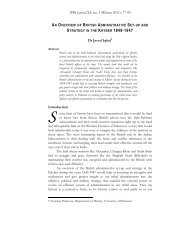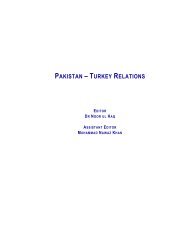120 Whither Kashmir? (Part II) - Islamabad Policy Research Institute
120 Whither Kashmir? (Part II) - Islamabad Policy Research Institute
120 Whither Kashmir? (Part II) - Islamabad Policy Research Institute
Create successful ePaper yourself
Turn your PDF publications into a flip-book with our unique Google optimized e-Paper software.
80 IPRI Factfile<br />
the adjudicative process, we would suggest that they make a request to<br />
the World Court not for an actual settlement of the dispute but for<br />
indicating the guidelines on the basis of which they would then engage in<br />
bilateral negotiations to solve the dispute in the spirit of the Simla<br />
Accord. There is a precedent in the North Sea Continental Shelf case<br />
where the parties in dispute asked the Court to decide the applicable<br />
principles and rules of international law rather than actually delimit the<br />
boundaries of the continental shelf in dispute. On the basis of these<br />
guidelines they then proceeded to resolve their dispute.<br />
One may ask here as to how to overcome the hurdles created by<br />
the Indian Declaration accepting the compulsory jurisdiction of the<br />
World Court. There are at least four such hurdles which prohibit the<br />
submission of disputes to the Hague Court which are as follows:<br />
a) disputes in regard to which the parties to the dispute have<br />
agreed or shall agree to have recourse to some other method<br />
or methods of settlement (obliquely referring to the so-called<br />
bilateralism of the Simla Agreement);<br />
b) disputes with a State which is or has been a member of the<br />
British Commonwealth;<br />
c) disputes relating to or connected with, among other things,<br />
fulfilment of obligations imposed by international bodies: and<br />
d) disputes concerning or relating to, among other things, the<br />
status of its territory or the modification or delimitation of its<br />
frontiers or any other matter concerning boundaries (oblique<br />
reference to the State of Jammu and <strong>Kashmir</strong>). It is true that<br />
India has built a series of hurdles to protect herself against any<br />
country trying to drag her before the World Court.<br />
However, despite these hurdles, India can, if she so desires, set<br />
aside these hurdles by making a declaration accepting the<br />
Court's jurisdiction for the special purpose of seeking<br />
guidelines for the resolution of the <strong>Kashmir</strong> dispute.<br />
As far as Pakistan's Declaration is concerned, it seems to pose much<br />
less problems. It takes out only two categories of disputes from the ambit<br />
of the Court which are as follows:<br />
a) disputes the solution of which the parties shall entrust to<br />
other tribunals by virtue of agreements;<br />
b) disputes relating to questions which by international law fall<br />
exclusively within the domestic jurisdiction of Pakistan. It is




